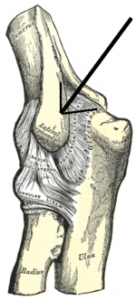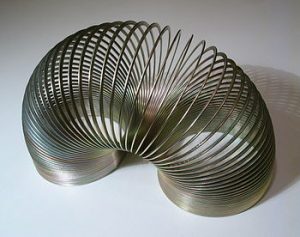Tennis elbow; Why it takes more than cortisone to solve this frustrating problem.
this frustrating problem.
Tennis elbow is defined as pain in the lateral part of the elbow and often is called an overuse injury. Why it is it overuse for them and not for someone who does exactly what you do athletically, yet you are the one in pain? Wikipedia describes the condition in detail as follows:
“Tennis elbow or lateral epicondylitis is a condition in which the outer part of the elbow becomes sore and tender. The forearm muscles and tendons become damaged from overuse “” repeating the same strenuous motions again and again. This leads to pain and tenderness on the outside of the elbow.[1]
Any activity, including playing tennis, which involves the repetitive use of the extensor muscles of the forearm can cause acute or chronic tendonitis of the tendinous insertion of these muscles at the lateral epicondyle of the elbow. The condition is common in carpenters and other laborers who swing a hammer or other tool with the forearm, continuing activity after onset of the condition and avoiding mandatory rest may lead to the permanent onset of pain and only treatable via surgery.”
When you are learning how to play, a tennis pro will usually recommend changes to your form or how you hit the ball including how you use your body to set up for a shot. Your mileage may vary as many players sink back into their bad body movement patterns and habits. What most tennis pro’s never looked at is your body style, and they assume we should all move the same way but in reality, body styles differ markedly from person to person and we adapt to this with our version of their form.
In the box thinking physicians often suggest a medication, icing after the activity,a brace to reduce the pain or may inject the area with cortisone which can often relieve the condition, as described in Wikipedia. The bad news is that according to studies such as one featured in the BMC Musculoskeletal disorders journal in 2015 had shown that the effect of cortisone is usually short-lived when the only management had been a cortisone injection (1) when compared to those treated with friction therapy massage, stretches, and exercises. A year later, the cortisone group felt much worse. You can read more about this in a recently published NY Times article here.

Dr. Olaussen, one of the publishers of this study is still perplexed as to why the group who had the cortisone-only treatment felt worse. Perhaps, it is because friction massage actually causes changes in the fibrous nature of the scar at the point of stress in the elbow, something Dr. Cyriax who originally described this treatment method had originally realized. Currently, instrument-assisted soft tissue methods used by our office and many others is used to similar effect although it is more efficient in how it works.
Is tennis elbow a problem of the elbow and its overuse or is it really a problem of body movement and improper adaptations of movement that stresses the elbow?
For those who are unfamiliar with how we move, especially with tennis or other sports, you swing using whole-body movements instead of using just the arm and rotations of the wrist, movements that will often cause elbow pain. Holding the racket too tightly or using the wrong size grip is also considered a precursor to elbow pain. What about the hips or the pelvis; aren’t they required when playing tennis?
If there are movement disorders in the hips or asymmetries with our gait or the way we move, we will compensate in our upper body and our form used for swinging a racket will be affected. Most people fail to realize that poor performance in a sport may be a direct result of body mechanics, rather than just a bad game.
When pain becomes the problem, many of us will grab a brace and continue to play until that also does not work. Most doctors recommend these braces for relief of the condition, yet, when you remove the brace, the problem is just as painful as it was before. Other doctors of conventional wisdom tell their patients to rest the area, yet, when they return to play, so does the pain. Medications are useless as these problems are mechanical.
To solve tennis elbow, we must look at the body, how we walk, run and move and how our arm is able to move both in overhead and in backhand and forehand motions. Having pain when performing those seemingly simple motions is often what gets people to a doctor.
A doctor or therapist looking at just the elbow should be a red flag since the elbow is usually the symptom, rather than the problem? Yo ur likelihood of treatment success depends on the healthcare provider understands what is straining the elbow. Changing the way you move can be achieved with myofascial release or instrument-assisted soft tissue since tight and dysfunctional core muscles will affect the legs, shoulders, and elbows as well. Many movement patterns are also learned by the brain using neuroplasticity and once an area moves better, often proper mechanics need to be relearned as well, a process that may take months.
ur likelihood of treatment success depends on the healthcare provider understands what is straining the elbow. Changing the way you move can be achieved with myofascial release or instrument-assisted soft tissue since tight and dysfunctional core muscles will affect the legs, shoulders, and elbows as well. Many movement patterns are also learned by the brain using neuroplasticity and once an area moves better, often proper mechanics need to be relearned as well, a process that may take months.
Human movement is not unlike a Slinky, those toy springs that go back and forth. When we grab a large part of the spring, the other parts tend to strain and the forces on the other part of the slinky will deform or affect the shape of the spring and the way it moves. The human body is not that much different except that movement according to the book Cheating Mother Nature, what you need to know to beat chronic pain (2) is affected either negatively by connective tissue called the myofascia. If the myofascia has shortened and tightened, it will affect the way we move and that will affect our back, our hips, and even our shoulders. Tom Myers in his book, Anatomy Trains (3) goes into detail about the fascial system and how it is actually an exoskeleton of sorts with a neurological network that is even more important than the muscles and tissues that are surrounded by it.
Since the myofascia forms according to the forces we place upon it, if we are built asymmetrically, which is quite common, the body will distort the hips and secondarily distort the upper back. This affects the core muscles which can no longer properly stabilize us in many of the activities we do and the more we load up the body, the tighter we will become which can affect the way the shoulders, neck, wrist and elbow feels and functions.
The tighter the lower back becomes, the more we load our legs, which will also get tighter. Our shoulders and forearm muscles will tighten as well, with the result being altered movement patterns and pain in areas such as the elbows where the tendons insert into.
Most people do not realize there is anything wrong since we have been built a certain way due to genetics, and we inherit those traits from our parents and pass them on to our children as well. When we reach the age of 6, we are walking much more like adults and if we are tight, we have no idea since the way we feel is our frame of reference for what we consider normal. As we grow, a woman’s hips will widen causing even more stress on an asymmetrical body style which is likely why adolescent girls have so many knee and back issues as well as scoliosis, something we are not covering in this article.
Better solutions for tennis elbow.
- Find a healthcare practitioner who looks at you, not just where you hurt. Most chiropractors have been trained to do this but those who are trained in methods such as myofascial release or Active Release Technique, a style of fascial release. Someone who has been trained in IASTM (instrument-assisted soft tissue methods) such as Graston Technique is also invaluable.
- If you are asymmetrically built (most sports chiropractors, many physical therapists, and some athletic trainers can spot this), wearing shoe inserts such as Superfeet or Power steps can be quite helpful. Custom insoles are helpful as well for those who break down off-the-shelf inserts quickly, and may be a better option for certain types of feet and gait.
- Spinal and extremity manipulation to restore joint mobility from tight myofascia after the muscle work has been performed. Chiropractors are best known for this type of work.
- Exercises to rehabilitate and reeducate the inappropriate body movement patterns that have developed over time.
1.BMC Musculoskeletal Disorders201516:122 DOI: 10.1186/s12891-015-0582-6 © Olaussen et al.; licensee BioMed Central. 2015 Published: 20 May 2015.
2.Cheating Mother Nature: What You Need To Know To Beat Chronic Pain Paperback ““ by William D. Charschan D.C.C.C.S.P. (Author), Mark Daniels (Editor) CreateSpace Independent Publishing Platform (August 25, 2011)
3.Anatomy Trains: Myofascial Meridians for Manual and Movement Therapists, 3e 3rd Edition by Thomas W. Myers (Author) Churchill Livingstone; 3 edition (February 25, 2014)
About the author: Dr. William Charschan has treated hundreds of cases of tennis elbow successfully and maintains two offices in North Brunswick and Scotch Plains NJ. He has been in private practice since 1988 and is an ICCSP (Internationally Certified Sports Chiropractor).